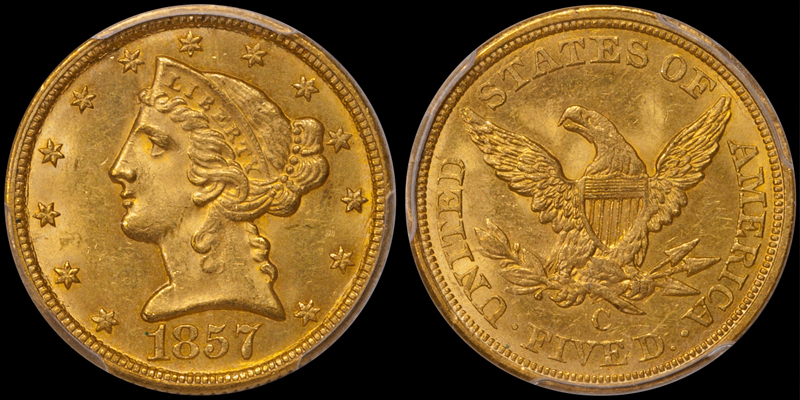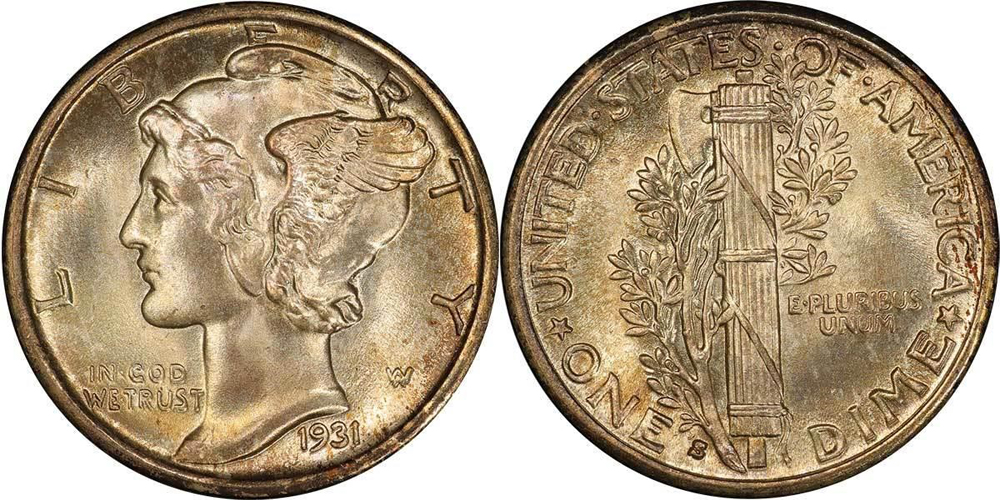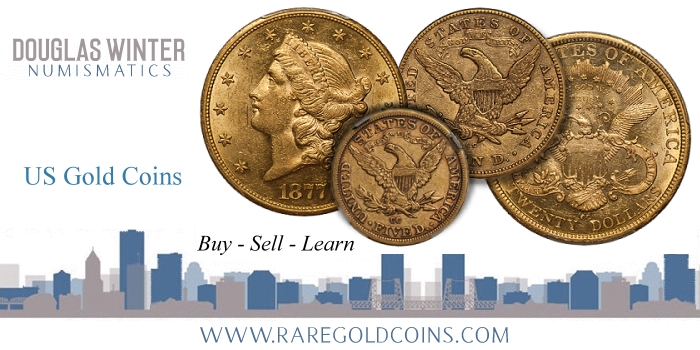
By Doug Winter – RareGoldCoins.com ……
CoinWeek Content Partner ……
In the Arlington Collection Concierge Sale (which I am currently offering on my website), there are a number of really exceptional coins. One of my favorites is a PCGS/CAC MS63 1857-C half eagle that I sold to a Midwestern collector
This coin–about which I will go into detail in a few moments–was priced on my site at $28,500 USD, which I thought represented great value. I know it’s hard to make a compelling case for a solid five-figure gold coin being undervalued but it is my opinion that this museum-quality piece is, in fact, very undervalued. It is my belief that truly exceptional U.S. gold coins of this ilk are underappreciated for a number of reasons (some sensible, some not-so-sensible), and in this article, we’ll look at a few of these reasons.

1857-C $5.00 PCGS MS63 CAC, from the Arlington Collection. Image courtesy Douglas Winter Numismatics
Before we do this, let me give you a little background about the 1857-C half eagle and its numismatic significance. As a date, this is a reasonably available Charlotte issue with over 300+ known in all grades. It is not especially scarce in About Uncirculated, although properly graded AU55 and AU58 examples are not easily located. In Uncirculated, this is a rare issue with an estimated 12-15 extant, mostly in the MS60 to MS62 range. There are three pieces known to me in MS63 or finer, and the single best known is an NGC MS64 pedigreed to the Elrod Collection.
The Arlington Collection 1857-C half eagle was graded MS63 by PCGS and approved by CAC. I had sold it to the collector over a decade ago in an NGC MS63 holder, and I crossed it prior to making it available. The coin is exceptional with totally original color, great luster, and choice surfaces which show only a few light scuffs.
It is interesting to note that while lower-grade Charlotte half eagles (and quarter eagles as well) have performed well from a price perspective over the last two decades, really high-end coins have not done well. In fact, there was an auction record of $23,100 for a nice NGC MS63 1857-C half eagle as far back as May 1995. Why have prices for collector-grade branch mint half eagles doubled in the past 20 years (i.e, an 1857-C half eagle in EF40) while an MS63 example of this date has stayed flat?
I have a few ideas why.
1. Branch Mint Half Eagles Don’t Have Aggressive Registry Set Participation
The PCGS Set Registry has forever changed the market for such series as Lincoln cents, Mercury dimes, Standing Liberty quarters, and Walking Liberty half dollars. Each of these series has a number of aggressive participants at the top end of the market and this can lead to crazy prices when a population one/none better coin comes available.

1931-S 10C PCGS MS67+ FB CAC. Image courtesy Legend Numismatics
A perfect example of this just occurred in the Legend June 2019 sale where a 1931-S dime graded MS67+ Full Bands by PCGS/CAC brought $270,250 on an estimate of $22,000-25,000 (the prior lot, a 1931-S dime in PCGS/CAC MS66 Full Bands, brought $3,760), and a 1938-S PCGS/CAC MS68+ Full Bands brought $364,250 on an estimate of $10,000-12,500 (the prior lot, a 1938-S dime in PCGS/CAC MS67+ Full Bands, brought $1,880).
There are some active buyers of 1857-C half eagles in PCGS MS63, but they aren’t competing on the Registry. Because of this, rare low-population coins don’t have the Registry “value” that a 1938-S dime has in PCGS MS68+ Full Bands. Seems crazy, but this is the reality of the Registry-driven segment of the coin market in 2019 and likely beyond.
2. Branch Mint Half Eagles Are Too Rare in Higher Grades for Most Wealthy Collectors to Appreciate
The series I just mentioned above are popular with collectors because of the fact that every date exists in Gem Uncirculated and, in the case of Mercury dimes, in Superb Gem Uncirculated. The three finest known sets of Charlotte half eagles ever assembled (Stanley Elrod, Harry Bass, and Paul Dingler) contained no coins graded higher than MS65, and only a small number in MS63 and MS64.
If you’ve been conditioned to look at coins that grade MS66, 67, or even 68, you aren’t going to be able to embrace coins like an MS63 1857-C half eagle; even if said coin is demonstrably rare and likely the finest available.
A quick look at the PCGS Set Registry shows only two sets registered for Charlotte half eagles. The finer of the two is owned by mega-collector D.L. Hansen and while this set contains a number of significant individual coins, it is probably among the least impressive sets in Hansen’s overall collection. It isn’t any better because it doesn’t have to be.
If three new collectors began Charlotte half eagle sets and the Registry became more competitive, you can be sure that Mr. Hansen would pay more attention to the fact that his 1851-C half eagle only grades AU53 or his 1855-C is only an AU58. The competition in the Mercury Dime Set Registry is brutally intense and this leads to purchases such as the $364,250 1938-S dime.
3. Assembling a Finest Known Set of High-Grade Branch Mint Half Eagles Takes a Long Time
The beauty of many 20th-century sets is that high-grade coins are available with a good degree of regularity. Let’s take a look at the 1919-D dime in MS66 Full Bands which is the key strike rarity of the Mercury dime series.
There are a total of six graded as such by PCGS with three also approved by CAC. There are none finer, so a top-rung Registry Set will focus on one of these. One sold at auction in January 2019, another sold in September 2015, another in April 2012, and another in August 2010. That’s a total of four so far in this decade and this doesn’t include private treaty sales. Clearly, this is a rare coin but the chances are good that if you want one you won’t have to wait longer than two to three years.
Now, let’s look at the degree of frequency for appearances of high grade (MS63 to MS64) 1857-C half eagles. Since 2000, one has appeared in PCGS MS63 (2014), one has appeared in NGC MS63 (2004), and one has appeared in NGC MS64 (2000 and 2003). These numbers show that, if you are really lucky, you’ll get one shot at a really nice MS63 to MS64 1857-C half eagle per decade. If you’re an impatient wealthy collector who is used to getting what you want when you want it, then that’s going to be a problem.
4. Coin Doctoring Thins the Herd
Sadly, many higher grade branch mint half eagles (not to mention a lot of dated gold in general) have been doctored. This diminishes already tiny populations and makes it harder for collectors to put together meaningful sets of high-grade coins.
Let’s look at the 1857-C half eagle as an example.
The only auction record for a PCGS MS63 is Heritage 2014 FUN: 5452, which brought $22,325. This seems like a weak result and it is when one considers the fact that a nicer NGC MS63 brought $23,100 all the way back in May 1995. (It is also interesting to note that a pleasing, accurately graded PCGS/CAC MS62 sold for $17,825 as Heritage 2012 FUN: 4899.) You’d think that if a nice MS62 is worth close to $18k, a nice MS63 would be a no-brainer at $35,000+. But I digress…
Since the market for MS63 1857-C half eagles is extremely thin and since only one coin has traded in over two decades, the price was set by this cheap APR. I would contend that the coin that sold in 2014 was, in fact, no better than an MS62 and that a nice CAC-quality MS63 should, in fact, be worth $35,000-40,000+. But I’m unable to justify such a price unless one comes available in auction sometime in the future and brings what I feel it’s really worth.
I focused on branch mint half eagles for this blog but the subject could have just as easily have been quarter eagles or eagles. The point I’ve tried to make is that in this crazy, Registry-driven coin market of 2019, real coins like MS63 1857-C half eagles seem like great values when compared to common date $364,250 Mercury dimes.
Are you interested in buying important condition rarities like PCGS/CAC MS63 1857-C half eagles? Douglas Winter Numismatics is the source for choice, rare US gold and we sell more important Condition Census branch mint 19th-century gold than any other coin firm. Please contact Doug at (214) 675-9897 for more information.

* * *
About Doug Winter
 Doug has spent much of his life in the field of numismatics; beginning collecting coins at the age of seven, and by the time he was 10 years old, buying and selling coins at conventions in the New York City area.
Doug has spent much of his life in the field of numismatics; beginning collecting coins at the age of seven, and by the time he was 10 years old, buying and selling coins at conventions in the New York City area.
In 1989, he founded Douglas Winter Numismatics, and his firm specializes in buying and selling choice and rare United States coins, especially US gold coins and all branch mint material.
Recognized as one of the leading specialized numismatic firms, Doug is an award-winning author of over a dozen numismatic books and the recognized expert on US Gold. His knowledge and exceptional eye for properly graded and original coins has made him one of the most respected figures in the numismatic community and a sought after dealer by collectors and investors looking for professional personalized service, a select inventory of impeccable quality and fair and honest pricing. Doug is also a major buyer of all US coins and is always looking to purchase collections both large and small. He can be reached at (214) 675-9897.
Doug has been a contributor to the Guidebook of United States Coins (also known as the “Redbook”) since 1983, Walter Breen’s Encyclopedia of United States and Colonial Coins, Q. David Bowers’ Encyclopedia of United States Silver Dollars and Andrew Pollock’s United States Pattern and Related Issues
In addition he has authored 13 books on US Gold coins including:
- Gold Coins of the New Orleans Mint: 1839-1909
- Gold Coins of the Carson City Mint: 1870 – 1893
- Gold Coins of the Charlotte Mint: 1838-1861
- Gold Coins of the Dahlonega Mint 1838-1861
- The United States $3 Gold Pieces 1854-1889
- Carson City Gold Coinage 1870-1893: A Rarity and Condition Census Update
- An Insider’s Guide to Collecting Type One Double Eagles
- The Connoisseur’s Guide to United States Gold Coins
- A Collector’s Guide To Indian Head Quarter Eagles
- The Acadiana Collection of New Orleans Coinage
- Type Three Double Eagles, 1877-1907: A Numismatic History and Analysis
- Gold Coins of the Dahlonega Mint, 1838-1861: A Numismatic History and Analysis
- Type Two Double Eagles, 1866-1876: A Numismatic History and Analysis
Finally, Doug is a member of virtually every major numismatic organization, professional trade group and major coin association in the US.




